An Indian paramilitary soldier asks residents to stay indoors as they patrol a street vandalized in Tuesday's violence in New Delhi, India, Thursday, Feb. 27, 2020. India accused a U.S. government commission of politicizing communal violence in New Delhi that killed at least 30 people and injured more than 200 as President Donald Trump was visiting the country. The violent clashes between Hindu and Muslim mobs were the capital's worst communal riots in decades and saw shops, Muslim shrines and public vehicles go up in flames. (AP Photo/Altaf Qadri)
The Associated Press
NEW DELHI (AP) - India's hard-line Hindu nationalists watched anti-government protests centered in Muslim communities for months in anger that finally boiled over in the worst communal rioting in New Delhi in decades, leaving 32 people dead and the Indian capital shell-shocked.
Tensions had been building over a new citizenship law that critics see as a threat to India's secular society and a way to further marginalize the country's 200 million Muslims.
As Prime Minister Narendra Modi feted U.S. President Donald Trump on his first state visit to India, a moment that was supposed to help cement the country's place on the world stage instead became an embarrassment.
On Sunday, as Modi prepared for Trump's arrival, a group of predominantly Muslim protesters demonstrated in a northeastern corner of the capital against the citizenship law, which fast-tracks naturalization for some religious minorities from neighboring countries but not Muslims.
Kapil Mishra, a local leader of Modi's Bharatiya Janata Party who lost his Delhi state assembly seat in recent elections, held his own rally, urging police to clear out the protesters.
'œThey want Delhi to burn,'ť Mishra said with a police official standing beside him. 'œI am saying this on behalf of the crowd that we will be peaceful until Trump is here. Once he leaves, we won't even listen to you if the roads aren't cleared of demonstrators,'ť he said, referring to the police.
By Friday, the death toll from the violence that followed, between Hindus and Muslims who had lived side by side for centuries but attacked each other with guns and swords, metal rods and axes, had risen to 38. More than 200 people were injured, New Delhi police said.
The streets where the rioting occurred, in Muslim and Hindu areas alike, resembled a war zone. Helmeted, camouflaged and baton-wielding police marched down pavements littered with broken glass and charred vehicles as residents peered fearfully from behind neighborhood gates they had locked from inside.
O.P. Mishra, joint commissioner of police, leading the march, said he was responsible for instilling in the residents 'œa sense of confidence that peace has returned.'ť
But a ban on groups of five or more people remained in place, and schools were closed.
Over a bullhorn, he urged people to go about their regular business, but acknowledged they were 'œapprehensive'ť to do so.
On one corner, Muslims accused police of aiding Hindu mobs in the clashes, including setting fire to mosques and a shrine.
Because New Delhi is a federal territory, Modi's government controls the city's police force, which reports to Home Minister Amit Shah - the prime minister's trusted confidante.
Down the street, police showed crude catapults on a burned and ransacked school building and behind a makeshift barrier that they accused Muslim rioters of using to attack Hindus living on the other side near an undamaged Hindu temple.
Police denied allegations that they aided the Hindu marauders or failed to stop violence against Muslims. But bystander videos appeared to show police standing by as Hindu men attacked Muslims. Other videos showed police commanding Muslims to sing India's national anthem. The Delhi High Court on Wednesday chided police for not stopping the mobs.
"The blood is on the hands of Kapil Mishra. He is responsible for the riots," said Hari Singh Solanki, a Hindu whose son was shot and killed during the riots.
Mishra, the local politician from Modi's party, did not respond to repeated phone calls and messages seeking comment.
Since cruising back to power in a general election last May, Modi has aggressively carried out his party's Hindu nationalist agenda, from stripping restive Kashmir, India's only Muslim-majority region, of its statehood, to supporting a Supreme Court ruling allowing a Hindu temple to be built on the site of a Mughal-era mosque torn down by Hindu mobs in 1992.
The citizenship law passed in December, seen as a precursor to a nationwide citizens registry that would culminate in the jailing or deportation of foreigners, appeared to embolden both his followers and his opponents.
The rampage by the mobs, mostly Hindus attacking Muslim homes and places of worship, was a jarring reminder of the rising religious tensions under Modi.
On Wednesday, the U.S. Commission on International Religious Freedom said it was deeply troubled by the violence and cited accounts that police had not intervened in attacks against Muslims.
'œThe government is failing in its duty to protect its citizens,'ť Commissioner Anurima Bhargava wrote.
India's External Affairs Ministry said the commission's comments were 'œfactually inaccurate and misleading'ť and appeared to be 'œaimed at politicizing the issue.'ť
Indian paramilitary soldiers patrol a street vandalized in Tuesday's violence in New Delhi, India, Thursday, Feb. 27, 2020. India accused a U.S. government commission of politicizing communal violence in New Delhi that killed at least 30 people and injured more than 200 as President Donald Trump was visiting the country. The violent clashes between Hindu and Muslim mobs were the capital's worst communal riots in decades and saw shops, Muslim shrines and public vehicles go up in flames. (AP Photo/Altaf Qadri)
The Associated Press

An Indian Muslim boy stands inside a mosque burnt in Tuesday's violence in New Delhi, India, Thursday, Feb. 27, 2020. India accused a U.S. government commission of politicizing communal violence in New Delhi that killed at least 30 people and injured more than 200 as President Donald Trump was visiting the country. The violent clashes between Hindu and Muslim mobs were the capital's worst communal riots in decades and saw shops, Muslim shrines and public vehicles go up in flames. (AP Photo/Altaf Qadri)
The Associated Press

A Muslim woman cleans a shrine burnt in Tuesday's violence in New Delhi, India, Thursday, Feb. 27, 2020. India accused a U.S. government commission of politicizing communal violence in New Delhi that killed at least 30 people and injured more than 200 as President Donald Trump was visiting the country. The violent clashes between Hindu and Muslim mobs were the capital's worst communal riots in decades and saw shops, Muslim shrines and public vehicles go up in flames. (AP Photo/Altaf Qadri)
The Associated Press
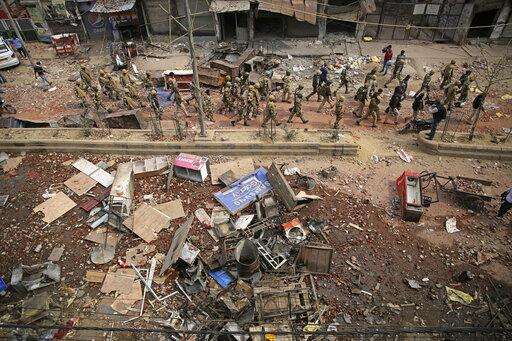
Indian paramilitary soldiers patrol a vandalized street in Tuesday's violence in New Delhi, India, Thursday, Feb. 27, 2020. India accused a U.S. government commission of politicizing communal violence in New Delhi that killed at least 30 people and injured more than 200 as President Donald Trump was visiting the country. The violent clashes between Hindu and Muslim mobs were the capital's worst communal riots in decades and saw shops, Muslim shrines and public vehicles go up in flames. (AP Photo/Altaf Qadri)
The Associated Press
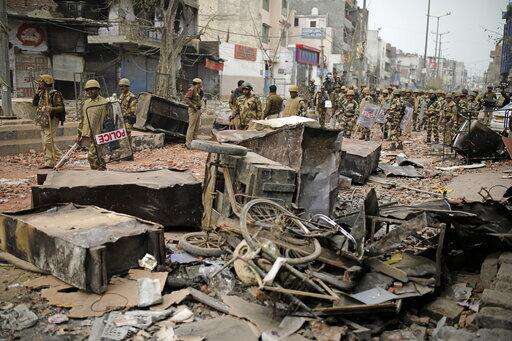
Indian paramilitary soldiers patrol a street vandalized in Tuesday's violence in New Delhi, India, Thursday, Feb. 27, 2020. India accused a U.S. government commission of politicizing communal violence in New Delhi that killed at least 30 people and injured more than 200 as President Donald Trump was visiting the country. The violent clashes between Hindu and Muslim mobs were the capital's worst communal riots in decades and saw shops, Muslim shrines and public vehicles go up in flames. (AP Photo/Altaf Qadri)
The Associated Press
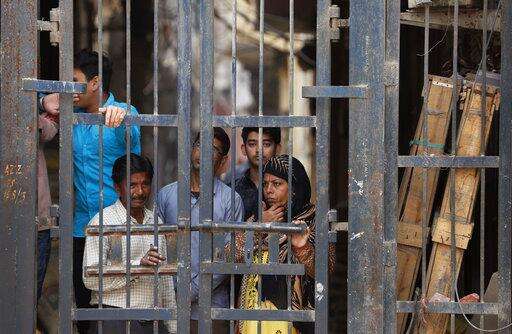
Residents look from behind a closed iron gate of their alley in Karaval Nagar following Tuesday's violence in New Delhi, India, Thursday, Feb. 27, 2020. India accused a U.S. government commission of politicizing communal violence in New Delhi that killed at least 30 people and injured more than 200 as President Donald Trump was visiting the country. The violent clashes between Hindu and Muslim mobs were the capital's worst communal riots in decades and saw shops, Muslim shrines and public vehicles go up in flames. (AP Photo/Rajesh Kumar Singh)
The Associated Press
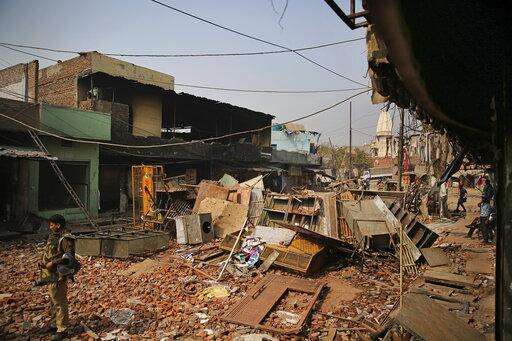
A Delhi policeman stands guard at a street vandalized in Tuesday's violence in New Delhi, India, Thursday, Feb. 27, 2020. India accused a U.S. government commission of politicizing communal violence in New Delhi that killed at least 30 people and injured more than 200 as President Donald Trump was visiting the country. The violent clashes between Hindu and Muslim mobs were the capital's worst communal riots in decades and saw shops, Muslim shrines and public vehicles go up in flames. (AP Photo/Altaf Qadri)
The Associated Press
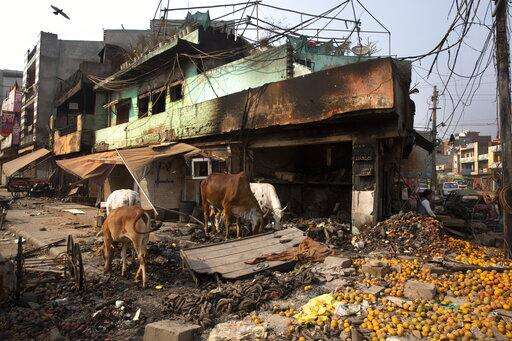
Stray cows feed on oranges lying outside a vandalized and burned shop following Tuesday's violence in New Delhi, India, Thursday, Feb. 27, 2020. India accused a U.S. government commission of politicizing communal violence in New Delhi that killed at least 30 people and injured more than 200 as President Donald Trump was visiting the country. The violent clashes between Hindu and Muslim mobs were the capital's worst communal riots in decades and saw shops, Muslim shrines and public vehicles go up in flames. (AP Photo/Rajesh Kumar Singh)
The Associated Press
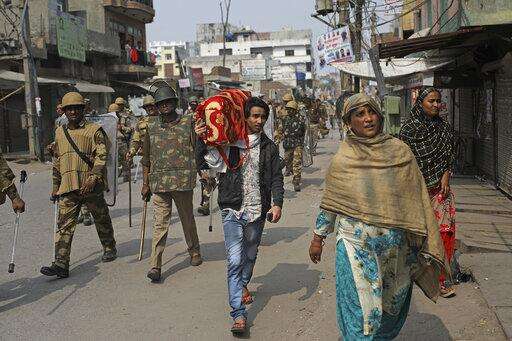
An Indian Muslim family leaves the area as Indian paramilitary soldiers patrol a street vandalized in Tuesday's violence in New Delhi, India, Thursday, Feb. 27, 2020. India accused a U.S. government commission of politicizing communal violence in New Delhi that killed at least 30 people and injured more than 200 as President Donald Trump was visiting the country. The violent clashes between Hindu and Muslim mobs were the capital's worst communal riots in decades and saw shops, Muslim shrines and public vehicles go up in flames. (AP Photo/Altaf Qadri)
The Associated Press